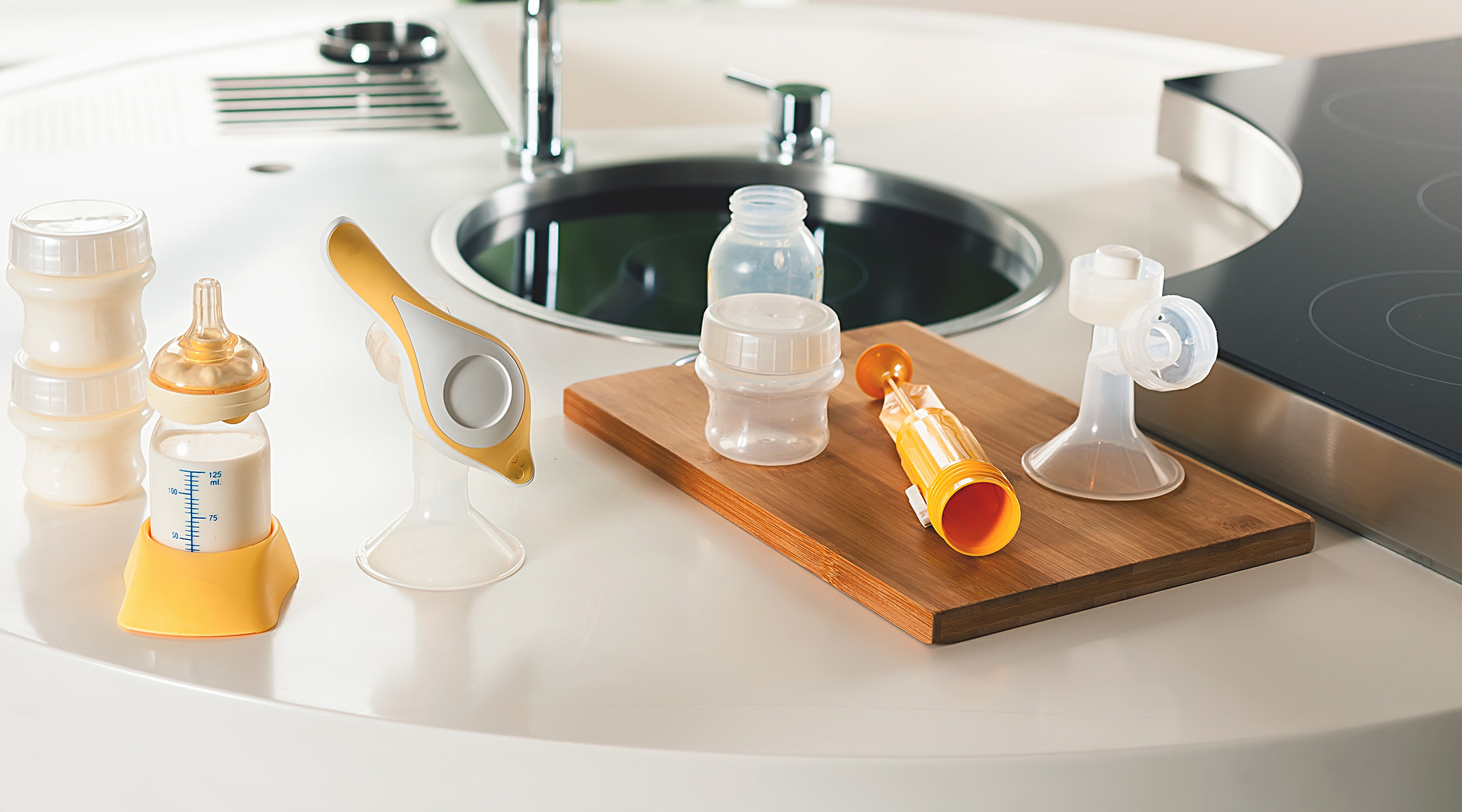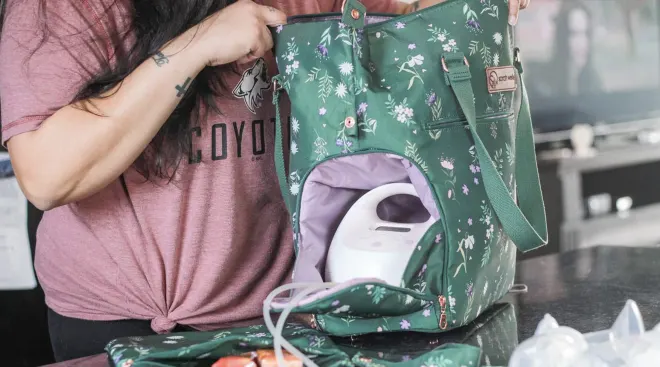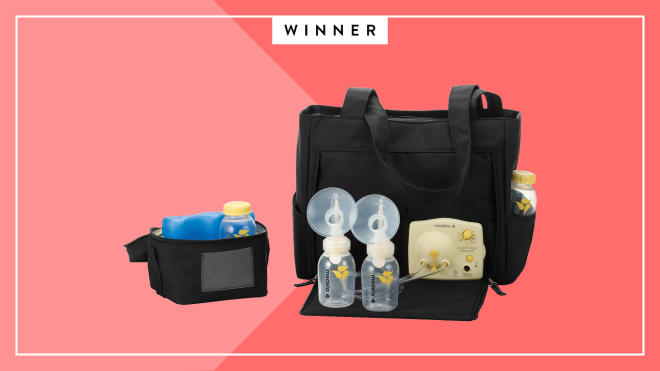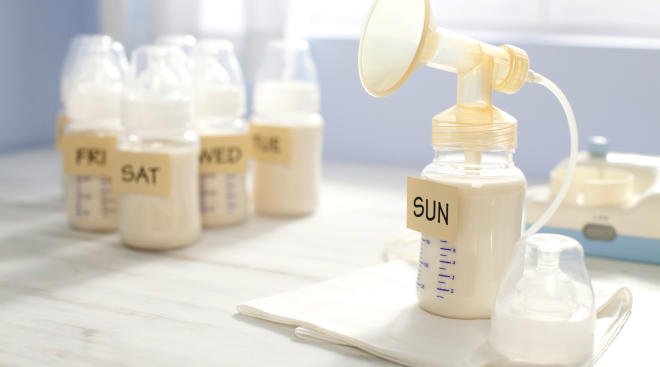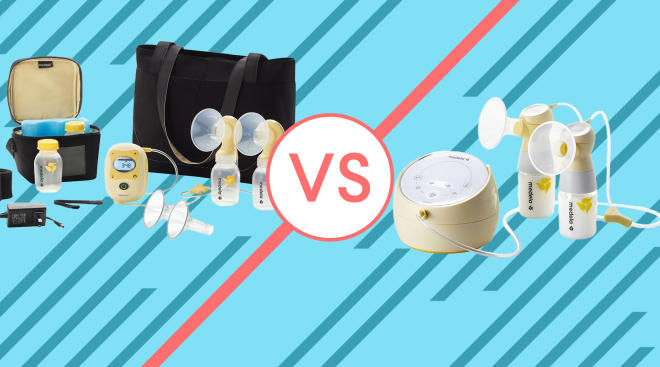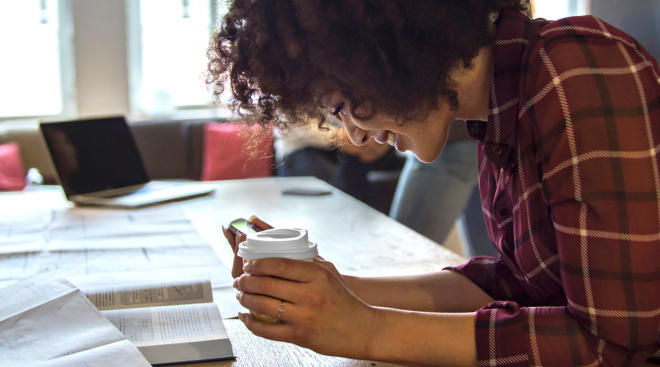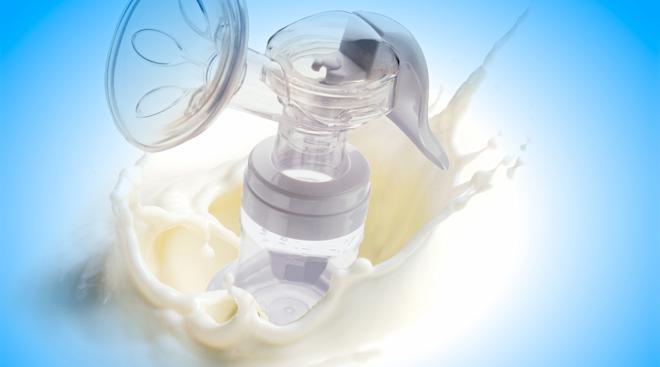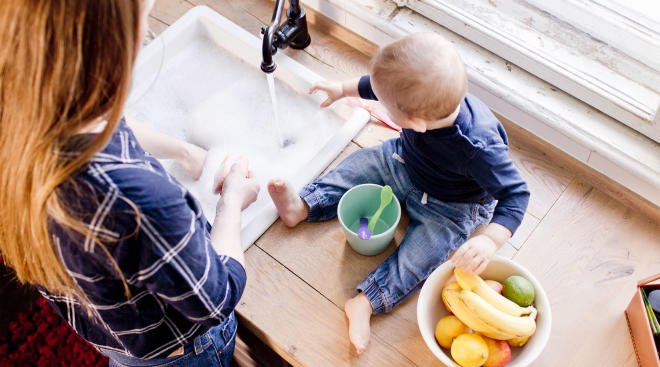Pumping 101: How to Pump Breast Milk
Whether you’re going out for the evening, heading back to work or just need a break from breastfeeding, at some point most new moms rely on a breast pump. The convenient contraption can do a lot more than allow you to fill a bottle with your breast milk. A breast pump is also handy for storing a backlog of milk in your freezer, helping to keep your milk supply flowing and prevent engorgement. But for new moms, the process of pumping breast milk can seem intimidating. When should you start pumping breast milk, how often should you pump and how do you actually go about doing it? We’ve got your answers.
When to start pumping breast milk “is very much dependent on the experience the mom and baby are having,” says Jenny Thomas, MD, IBCLC, a pediatrician at Aurora Health Care in Milwaukee, and an executive committee member for the American Academy of Pediatrics (AAP) Section on Breastfeeding. But if breastfeeding is going well and mom doesn’t have to return to work immediately, experts don’t recommend pumping breast milk for the first four to eight weeks. “Baby has a natural [sucking] rhythm that can help increase milk supply, which a pump doesn’t have,” Thomas says. “Plus, a pump won’t remove as much milk as babies do.”
However, there are certain circumstances in which a mom should start pumping breast milk earlier, says Lori J. Isenstadt, IBCLC, RLC, a lactation consultant and owner of All About Breastfeeding, a lactation consulting service in Peoria, Arizona. The most common reasons are:
• If baby was born prematurely or has a health issue. “The No. 1 reason I’d suggest a new mom begin pumping breast milk is if baby is unable to breastfeed, was born premature, has a health issue, is in the NICU or otherwise has to be separated from mom,” Isenstadt says.
• If baby loses too much weight. If baby isn’t able to get enough milk from nursing at the breast, “pumping will let mom bottle-feed baby with breast milk to eliminate continued weight loss,” she says.
• If mom has to go back to work. “I suggest that mom begin pumping and storing breast milk about three weeks before she returns to work,” Isenstadt says. “This will give her the time needed to store enough milk for her first few days back at work.”
To ensure your milk supply doesn’t take a hit, the general rule of thumb is to pump whenever baby is being fed from a bottle, so your body still receives the signal to produce more milk.
If you’re preparing to return to work, start pumping breast milk about twice a day, Isenstadt says. “Always pump very shortly after baby has breastfed,” Isenstadt says. “If you pump too close to the next breastfeeding, baby will likely be frustrated with low volume, which will result in a poor feeding session.”
Once you’re back at work, try pumping breast milk about every three hours. If baby takes three bottles while you’re at work, pump three times when you’re out of the house. If baby takes four bottles when you’re gone, pump four times over the course of your work shift.
How much milk you should be pumping depends largely on your milk supply and baby’s age and weight. “Moms generally make enough milk to meet baby’s daily needs, which is around a liter a day,” says Lori Feldman-Winter, MD, MPH, head of adolescent medicine at Cooper University Hospital and professor of pediatrics at Cooper Medical School of Rowan University, in Camden, New Jersey. “But it really depends on the mother. Some can only pump another 3 to 6 ounces extra on top of what they’re already producing to feed baby. Others can store the equivalent of what they’re feeding baby.”
Of course, whether you’re still breastfeeding baby or are exclusively pumping will help determine how much milk you should be pumping. “Before you return to work, if you’re pumping shortly after a breastfeeding, you may only pump 0.5 ounces to 1 ounce or so per session. The amount depends on your overall volume,” Isenstadt says. “Once you’re back at work and the pump is totally replacing breastfeeding, you should be pumping approximately the same volume that baby takes from each bottle feeding. If you pump more, that’s great.”
As for how long to pump, once your milk has fully come in you should aim to pump until your breasts feel soft and emptied, or until about two minutes after the last drop of milk, to ensure you get it all. Depending on your milk supply and the type of breast pump you’re using, pumping sessions can last between 15 and 30 minutes.
There are a variety of ways to pump breast milk. But before you turn to a pump, it’s a good idea to learn how to hand-express your own milk. “It’s good for moms to get comfortable using their hands in expression,” Feldman-Winter says.
Other than hand expression, pumping breast milk can be done by using either an electric pump or a hand pump. Exactly how to pump breast milk depends on the type of breast pump you’re using. “Pumps are slightly different as far as handheld, single electric (one breast at a time), double electric (both breasts at a time), hands free and so on, so there isn’t one set of specific directions that will be relevant for all moms,” Isenstadt says. That said, there are a few general instructions for how to go about pumping breast milk:
• Step 1: Begin with clean hands and clean bottle equipment.
• Step 2: Place flanges over your breast tissue, making sure the opening of the flange is centered around your nipple.
• Step 3: Hold the parts against your breast with your thumb on the top part of the flange and your remaining fingers lying flat against the bottom part of the flange. Be careful not to press so hard on the breast tissue that it leaves marks on the skin.
• Step 4: Follow your pump instructions as to how to set the dials. Typically, you begin with a low suction and a quick speed. Once you have a steady flow, which usually takes about one to three minutes, you can lower the speed and increase the suction.
• Step 5: In order to complete a full pumping session, you’ll want to pump for about 15 to 20 minutes.
• Step 6: Once you’re done pumping, gently break the suction of the flanges and remove them from your breast. Carefully remove the baby bottle from each of the flanges (if you’re using a double breast pump) and set on a flat surface. Unplug your pump, place a cover on each bottle and keep cold.
• Step 7: Clean your pump using your individual pump manufacturer’s instructions.
Keep in mind that pumping should never be painful. “If pumping breast milk hurts, something is wrong with the machine setup,” Thomas says. “Either you have the wrong size flanges, or the level of suction is too high. If it still hurts after you make adjustments, seek out a lactation consultant and bring the pump along so she can help you get the right fit.”
To make the process as smooth and successful as possible, keep these breast pumping tips in mind:
• Invest wisely. When buying a breast pump, assess your priorities—such as budget, portability and baby’s needs (there are pumps specially designed for moms with premature babies, for instance)—then ask friends and experts for their opinion. If you’d rather not purchase one, many birthing hospitals rent quality breast pumps, and most Women, Infants and Children (WIC) offices can provide loaner pumps, depending on moms’ needs. You may even be able to get a free breast pump through your insurance. Note: It’s best not to buy or borrow a used pump due to the risk of cross-contamination. (Hospital-grade rentals are built with protective barriers and approved by the FDA for multiple users.)
• Always pump with breast pump flanges that fit properly. This might not be as obvious as it sounds. A lot of breast pumps come with adjustable flanges or a range of size options. A sign they’re fitting well: There’s a bit of space around your nipple, letting it move freely in the flange. You don’t want the areola to rub against the side of the flanges or be pulled into the flange tunnel as you pump. “A breastfeeding expert can help you find the right fit for you,” says Laura María Gruber, IBCLC, a lactation consultant and founder of Breastfeeding Housecalls, a lactation clinic near San Antonio.
• Get into a good mood before pumping. “Anything that causes stress is not good for milk volume, so get into a good mood when you’re about to start pumping breast milk,” Thomas says. “However you do that is up to you. Some people bring pictures of their kids, and some pumps let you record a soundtrack of your child so when you start pumping you can hear him cooing.”
• Buy a hands-free bra. “This enables the flanges to be held up by the bra,” Isenstadt says, “so mom doesn’t have to hold the flanges up herself, freeing her up to do something else with her hands while she’s pumping breast milk.”
• Don’t skip the nightly pumping. Some women, eager to get a full night’s sleep, pump extra milk before going to bed and then have their partner offer baby a bottle when she wakes up in the middle of the night. But be careful—while baby still gets a feeding in, it reads as a missed feeding for your body. If done too often, it impacts the milk supply,” Thomas says.
• Wait it out. “Ironically, the best pumping tip I can give is to hold off as long as necessary so mom’s milk supply has time to build itself based on baby’s latch and need,” Gruber says. “Moms who pump too early can sometimes cause oversupply, which comes with its own issues, like plugged ducts, mastitis and forceful letdown,” which is when too much milk comes out too quickly.
How long breast milk lasts after pumping depends on the storage method. Breast milk can last up to six to eight hours on the countertop, five days in the fridge and about six months in a freezer with a separate door. Be sure to store it in the back of the freezer instead of on the door, which tends to be warmer.
“The fresher the breast milk, the better,” Thomas says. “Milk is meant to go from breast to baby. Any time there’s an interruption, it changes the milk components but not enough to make it less better than formula. Refrigerating doesn’t alter the components nearly as much as freezing.” Once breast milk warms to room temperature, it shouldn’t be re-refrigerated or refrozen.
The best breast milk storage option for moms who are new to pumping are solid containers with tight lids, such as screw-cap bottles or hard plastic cups with tight caps, since breast milk bags can break. “As they feel comfortable, moms can venture to use bags,” Gruber says. “Laying the breast milk storage bags down flat will make thawing significantly easier, since it’ll freeze in a thin sheet of ice, which melts easily in hot water.” Remember that milk expands as it freezes, so be sure to leave a little extra room when sealing the bag.
Power pumping—or pumping at frequent intervals during the day—has been getting a lot of buzz as an easy way for moms to increase their milk supply. There are different ways to power pump, but a popular approach is to set aside an hour each day for pumping breast milk, pumping for the first 20 minutes, resting for 10 minutes, and then continuing to alternate pumping and resting every 10 minutes for the remainder of the time.
“Theoretically it mimics the supply and demand of a baby undergoing a growth spurt. It’s thought to stimulate the release of prolactin, a hormone that produces milk,” Thomas says. “But it’s very much based on theory, and I don’t know of any research that [supports the claim]. I’ve never recommended it; I think it would be very difficult to do.”
Feldman-Winter agrees, saying, “This method is not supported by the best evidence and may be helpful for some women but not all.” Like everything else when it comes to pumping, just listen to your body.
Published August 2017
Navigate forward to interact with the calendar and select a date. Press the question mark key to get the keyboard shortcuts for changing dates.
































